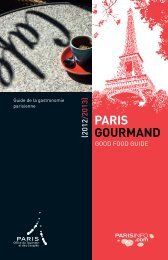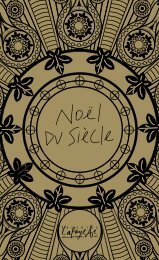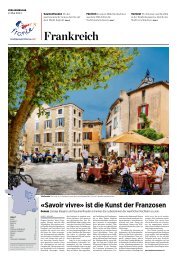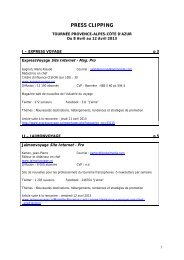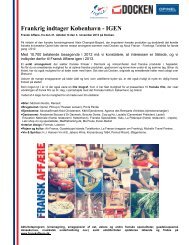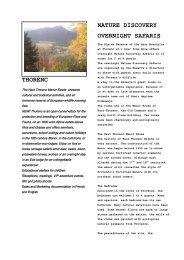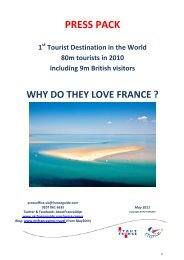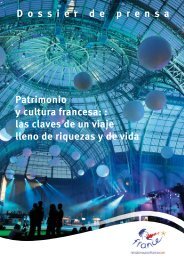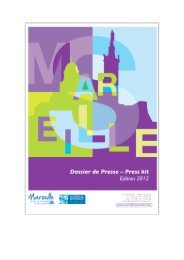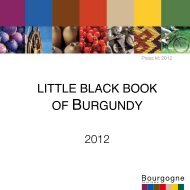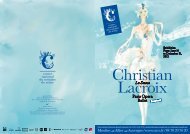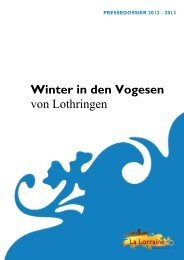DP MJCCSW 4.10_EN - copie - Maison de la France
DP MJCCSW 4.10_EN - copie - Maison de la France
DP MJCCSW 4.10_EN - copie - Maison de la France
Create successful ePaper yourself
Turn your PDF publications into a flip-book with our unique Google optimized e-Paper software.
Opens to the public on 6 November 2011<br />
Press re<strong>la</strong>tions:<br />
C<strong>la</strong>udine Colin Communication<br />
Dorélia Baird-‐Smith<br />
28, rue <strong>de</strong> Sévigné<br />
F-‐75004 Paris<br />
T: +33 (0)1 42 72 60 01 / +33 (0)6 70 55 01 54<br />
dorelia@c<strong>la</strong>udinecolin.com<br />
www.c<strong>la</strong>udinecolin.com<br />
ADVANCE PRESS KIT<br />
1
CONT<strong>EN</strong>TS<br />
I. Genesis of the project, a story of encounters p. 3<br />
§ Jean Cocteau and Menton<br />
§ Séverin Wun<strong>de</strong>rman, collector and benefactor<br />
§ Brief biographies: Jean-‐C<strong>la</strong>u<strong>de</strong> Guibal and Célia Bernasconi, assistance<br />
to the project<br />
§ Key dates and figures<br />
II. The museum’s collections p. 8<br />
§ A donation of 1800 works<br />
§ A museum itinerary tracing the life of Jean Cocteau<br />
§ The Lucien Clergue donation<br />
§ Overview of the collection<br />
§ Museum catalogue<br />
III. Temporary exhibitions p. 16<br />
§ Jean Sabrier Exhibition<br />
IV. A museum open to the town and its inhabitants p. 18<br />
V. The architectural project p. 19<br />
§ The project<br />
§ Key figures<br />
§ Architectural team<br />
§ Rudy Ricciotti: brief biography and major works<br />
§ Museographic <strong>de</strong>sign: Agence E<strong>DP</strong> & Associés<br />
VI. Visitor Information p. 25<br />
2
I. G<strong>EN</strong>ESIS OF THE PROJECT: A SERIES OF <strong>EN</strong>COUNTERS<br />
Thanks to an exceptional gift by Severin Wun<strong>de</strong>rman of works by Jean Cocteau, followed three<br />
years <strong>la</strong>ter by the <strong>la</strong>ying of the foundation stone for the building to house this collection, the<br />
musée Jean Cocteau collection Séverin Wun<strong>de</strong>rman in Menton, a <strong>la</strong>rge-‐scale cultural project<br />
which has received the full support of officials in this Côte d’Azur town, will open its doors to<br />
the public on Sunday, 6 November 2011.<br />
The future museum will thus become the leading and <strong>la</strong>rgest publicly accessible resource<br />
<strong>de</strong>voted to Cocteau’s oeuvre anywhere in the world.<br />
Jean Cocteau and Menton<br />
In the summer of 1955, while a house<br />
guest of his friend Francine Weisweiller at<br />
Saint-‐Jean-‐Cap-‐Ferrat, Cocteau visited<br />
Menton for the first time, was struck by<br />
the town’s beauty and would often return<br />
there in <strong>la</strong>ter years.<br />
In 1956, at the request of Menton’s<br />
mayor, the artist accepted a commission<br />
to re<strong>de</strong>corate the town hall’s wedding<br />
room with frescoes and other furnishings,<br />
a project he completed in 1958. In<br />
recognition, the town adopted Cocteau as<br />
an honorary citizen.<br />
Musée du Bastion, Menton<br />
© Ville <strong>de</strong> Menton<br />
Jean Cocteau<br />
Painted <strong>de</strong>coration for the Menton town hall wedding room:<br />
Lovers of Menton<br />
1957–1958<br />
© ADAGP, Paris 2011. Courtesy of Mr Pierre Bergé, chairman of<br />
the Comité Jean Cocteau.<br />
© Serge Caussé, photographer<br />
One day while strolling in Menton, Cocteau came upon<br />
the Bastion, a small, abandoned fort dating from the<br />
seventeenth century, built over water as an advance<br />
<strong>de</strong>fence for the port. He set his heart upon restoring<br />
this little jewel in or<strong>de</strong>r to exhibit his own artworks.<br />
The Musée Jean Cocteau opened its doors at the Bastion<br />
in 1966, three years after the <strong>de</strong>ath of the famed poet,<br />
choreographer, film-‐maker and artist. Decorated by<br />
Cocteau himself with mosaics and tapestries, this<br />
building is still home to a portion of the poet and<br />
artist’s paintings dating from his “Mediterranean”<br />
period (1950–1963).<br />
3
Severin Wun<strong>de</strong>rman, collector and benefactor<br />
Born in 1938 in Belgium and forced during the Second World<br />
War to seek exile in the United States, Severin Wun<strong>de</strong>rman rose<br />
from his beginnings as an apprentice watchmaker to become a<br />
leading figure in the Swiss luxury watchmaking industry.<br />
An art lover from his youth, with a particu<strong>la</strong>r interest in the<br />
works of Cocteau, he was only 19 when on a whim he acquired<br />
the first piece in his collection – an original drawing of a scene<br />
from the writer’s novel Les Enfants Terribles (The Holy Terrors)<br />
– spending nearly all of his first sa<strong>la</strong>ry payment as an apprentice<br />
watchmaker.<br />
He would continue to build up his collection over the years,<br />
founding a museum in Irvine, California to disp<strong>la</strong>y these works in<br />
1985. But his fervent wish was that a <strong>la</strong>rge number of the pieces<br />
in his collection would return to <strong>France</strong> one day, where a<br />
museum might give them a permanent home.<br />
Smitten with Menton, a town of great symbolic importance for any admirer of Cocteau, Severin<br />
Wun<strong>de</strong>rman arranged to meet <strong>de</strong>puty mayor Jean-‐C<strong>la</strong>u<strong>de</strong> Guibal, who helped him to bring this<br />
project to fruition.<br />
On 27 June 2005, following Wun<strong>de</strong>rman’s exceptional gift, the town of Menton, with the backing<br />
of <strong>France</strong>’s Ministry of Culture and Communication, entered into a commitment to build a public<br />
museum to house his collection. The foundation stone was <strong>la</strong>id on 29 December 2008, at a<br />
ceremony which Wun<strong>de</strong>rman was regrettably not able to attend as he had passed away just a<br />
few months earlier.<br />
In September 2005, the Ministry of Culture and Communication had approved the registration<br />
of the Severin Wun<strong>de</strong>rman collection as part of the holdings of the Musée Jean Cocteau in<br />
Menton, which has held the status of a “Musée <strong>de</strong> <strong>France</strong>”, alongsi<strong>de</strong> such institutions as the<br />
Louvre and the Pa<strong>la</strong>ce of Versailles, since 2003.<br />
Brief biographies<br />
Séverin Wun<strong>de</strong>rman<br />
© Ville <strong>de</strong> Menton<br />
Jean-‐C<strong>la</strong>u<strong>de</strong> Guibal, Deputy Mayor, Menton<br />
The shimmering light of his native Corsica and the potent i<strong>de</strong>ntity of the peoples of the<br />
Mediterranean have left their in<strong>de</strong>lible mark on Jean-‐C<strong>la</strong>u<strong>de</strong> Guibal, born in Ajaccio on 13<br />
January 1941. It was therefore quite natural that, after pursuing higher studies at a number of<br />
<strong>France</strong>’s most prestigious institutions – earning diplomas at HEC in 1963, the Institut d’Etu<strong>de</strong>s<br />
Politiques <strong>de</strong> Paris (Sciences Po) in 1965, the <strong>EN</strong>A in 1967 and named a reserve officer by the<br />
Ecole d’Application <strong>de</strong> l’Arme Blindée Cavalerie in Saumur (the training school for the armoured<br />
cavalry branch of the French Army) in 1966 – and following several positions in both the public<br />
and private sectors, Guibal then <strong>la</strong>unched his political career in Menton, becoming the town’s<br />
mayor in 1989, before being elected as its representative to the French National Assembly in<br />
1997.<br />
In this body, where he serves as a member of the Foreign Affairs Committee, his passion for the<br />
Mare Nostrum has led, among other distinctions, to his appointment as <strong>France</strong>’s representative<br />
to the Parliamentary Assembly for the Mediterranean.<br />
4
Committed to the preservation and promotion of Menton’s historical, architectural and<br />
botanical heritage, he has been instrumental in giving this Côte d’Azur town, a mere stone’s<br />
throw from the Italian bor<strong>de</strong>r, the status of a cultural <strong>de</strong>stination in its own right, where bold<br />
projects ennoble the spirit of the site and reinforce its authenticity.<br />
The conception of the musée Jean Cocteau collection Séverin Wun<strong>de</strong>rman, entrusted to the<br />
architect Rudy Ricciotti, whose use of light and line rivals that of his most celebrated<br />
pre<strong>de</strong>cessors, is the logical outgrowth of Guibal’s encounter with Severin Wun<strong>de</strong>rman and his<br />
<strong>de</strong>sire to pay homage to the artist who had chosen to give free rein to his expression in a p<strong>la</strong>ce<br />
he adored.<br />
Célia Bernasconi, Curator, musée Jean Cocteau collection Séverin Wun<strong>de</strong>rman<br />
Born in 1977, Célia Bernasconi was appointed curator of the musée Jean Cocteau collection<br />
Séverin Wun<strong>de</strong>rman in 2005.<br />
A graduate of the Université <strong>de</strong> Strasbourg and the Université <strong>de</strong> Paris I, Bernasconi holds a<br />
postgraduate <strong>de</strong>gree (DEA) in mo<strong>de</strong>rn and contemporary art history and is currently working<br />
towards her Ph.D at the Ecole <strong>de</strong>s Hautes Etu<strong>de</strong>s en Sciences Sociales un<strong>de</strong>r the guidance of<br />
Daniel Arasse. Bernasconi successfully completed the entrance exams for <strong>France</strong>’s national<br />
institute for cultural heritage (Institut National du Patrimoine) in 2002.<br />
She <strong>de</strong>veloped an interest in Cocteau’s works on paper as a logical extension of her studies<br />
focusing on the influence of the Florentine Early Renaissance painter Paolo Uccello (born Paolo<br />
di Dono) on twentieth-‐century artists. Along with Carlo Carra, Apollinaire, André Breton,<br />
Antonin Artaud and Paul Eluard, Cocteau rediscovered this painter with his painstaking<br />
attachment to perspective who had been spurned by his contemporaries, adopting him as a cult<br />
figure. In the 1920s, Cocteau signed his works “Jean l’Oiseleur”, in honour of his distant<br />
pre<strong>de</strong>cessor’s moniker, earned due to his fondness for painting birds.<br />
Project feasibility analysis and preliminary <strong>de</strong>sign team<br />
SA17 (Maïa Rabinowitz, Numa Granda Bonil<strong>la</strong>), architects and p<strong>la</strong>nners<br />
Frédéric Ladonne, architect, p<strong>la</strong>nner and specialist in preventive conservation<br />
Parica (Denis Vevaud), engineering <strong>de</strong>sign and economic analysis<br />
Among re<strong>la</strong>ted projects involving the participation of these same team members, SA17 and<br />
Frédéric Ladonne previously worked together on the study for the construction of the Picardie<br />
branch office of the FRAC (Fonds Régional d’Art Contemporain) at Amiens (the <strong>de</strong>sign by the<br />
Japanese architect Toyo Ito was selected). Frédéric Ladonne subsequently worked on projects<br />
for the Atelier-‐Musée du Verre (a g<strong>la</strong>ss museum and workshop at Trélon, near Avesnes), the<br />
Musée Archéologique Henri Pra<strong>de</strong>s at Lattes near Montpellier, the Musée <strong>de</strong>s Beaux-‐Arts at<br />
Dijon and the Musée <strong>de</strong>s Monuments Français at the Pa<strong>la</strong>is <strong>de</strong> Chaillot in Paris (with Parica).<br />
SA17 worked with Parica on the project for the construction of storerooms and renovation<br />
work at the Musée Ingres in Montauban. This project was led by Isabelle Crosnier, agent,<br />
architect and p<strong>la</strong>nner, who shared her particu<strong>la</strong>r expertise with Rabinowitz and Granda Bonil<strong>la</strong><br />
of SA17. The partnership with Isabelle Crosnier and Parica has continued, particu<strong>la</strong>rly in<br />
connection with projects for the refurbishment of the Musée Henri Martin at Cahors, the<br />
refurbishment of the Quadri<strong>la</strong>tère Richelieu (the former site of the Bibliothèque Nationale in<br />
Paris), the construction of storerooms for the Musée <strong>de</strong> Bayonne and the refurbishment of the<br />
Archives Nationales in Paris.<br />
5
musée Jean Cocteau collection Séverin Wun<strong>de</strong>rman: Key dates<br />
1 December 2003<br />
The project to build a new museum <strong>de</strong>dicated to Jean Cocteau and to Severin Wun<strong>de</strong>rman’s<br />
collection of the artist’s works is approved by the Menton municipal council<br />
September 2004<br />
The first expert analysis of Severin Wun<strong>de</strong>rman’s collection is carried out in Los Angeles<br />
17 June 2005<br />
Severin Wun<strong>de</strong>rman is presented with <strong>France</strong>’s highest distinction, the Légion d’Honneur, by<br />
Renaud Donnedieu <strong>de</strong> Vabres, Minister of Culture and Communication<br />
27 June 2005<br />
Signature of the donation agreement<br />
25 July 2005<br />
Menton adopts Severin Wun<strong>de</strong>rman as an honorary citizen<br />
1 September 2005<br />
Initiation of the p<strong>la</strong>nning phase for the museum, recruitment of Célia Bernasconi as the curator<br />
with overall responsibility for the project and for the integration of the future museum’s<br />
programming with its artistic mission<br />
October 2006<br />
Commissioning of the feasibility analysis and preliminary <strong>de</strong>sign for the project, awar<strong>de</strong>d to a<br />
team comprised of the architecture and p<strong>la</strong>nning firm SA17, the architect and museographic<br />
specialist Frédéric Ladonne, and the engineering, <strong>de</strong>sign and economic analysis firm Parica<br />
December 2006<br />
Official registration of the works inclu<strong>de</strong>d in the donation in the inventory of the musée Jean<br />
Cocteau<br />
15 May 2007<br />
Launch of the architectural <strong>de</strong>sign competition<br />
12 October 2007<br />
Press opening of the first preview exhibition of the musée Jean Cocteau collection Séverin<br />
Wun<strong>de</strong>rman at the Bastion<br />
27 June 2008<br />
Rudy Ricciotti is announced as the winner of the architectural competition<br />
Un<strong>de</strong>r the direction of Rudy Ricciotti, the winning <strong>de</strong>sign team also inclu<strong>de</strong>s Elizabeth <strong>de</strong><br />
Portzamparc for the museographic <strong>de</strong>sign and Agence APS for the <strong>la</strong>ndscaping <strong>de</strong>sign<br />
December 2008<br />
Demolition work begins<br />
29 December 2008<br />
Museum’s foundation stone is <strong>la</strong>id<br />
September 2009<br />
Campenon-‐Bernard is selected as the general contractor for the project’s earthworks and<br />
structural works<br />
6
October 2009<br />
Construction work begins<br />
15 January 2011<br />
Completion of earthworks and structural work<br />
February 2011<br />
Second expert analysis of Severin Wun<strong>de</strong>rman’s collection<br />
October 2011<br />
Final inspection of the building and the museographic <strong>de</strong>sign<br />
6 November 2011<br />
The museum opens to the public<br />
Finance<br />
Total project cost €11,780,000<br />
Contribution from the town of Menton of €5,380,000, 46% of the total<br />
Contribution from the Conseil Général <strong>de</strong>s Alpes-‐Maritimes of €4,000,000, 34% of the total<br />
Contribution from the Provence-‐Alpes Côte d’Azur Region of €1,200,000, 10% of the total<br />
Contribution from the State via the DRAC, of €1,200,000, 10% of the total<br />
7
II. The museum’s collections<br />
Gift of 1,800 works<br />
Severin Wun<strong>de</strong>rman’s donation consists of 1,800 works, including 990 works by Cocteau,<br />
offering a very comprehensive perspective on the artist’s career. All of its periods are<br />
represented, from the first self-‐portraits of the 1910s up to the “Mediterranean” period towards<br />
the end of his life, little known to the general public.<br />
The collection thus consists of drawings, prints, paintings, ceramics, tapestries, jewellery, books<br />
and manuscripts, but also 172 photographs re<strong>la</strong>ting to Cocteau (photographers represented<br />
inclu<strong>de</strong> Germaine Krull, Berenice Abbott, Irving Penn, Philippe Halsman, Boris Lipnitzky, Serge<br />
Lido, Sacha Masour and Lucien Clergue), 278 works by Cocteau’s fellow artists (Picasso,<br />
Modigliani, Foujita, Di Chirico, among others) as well as an exceptional grouping of 360 works<br />
re<strong>la</strong>ted to Sarah Bernhardt, in honour of whom Cocteau coined the expression “monstre sacré”<br />
(sacred monster).<br />
Apart from masterpieces representing the multiple facets of Jean Cocteau’s genius, the<br />
collection also sheds light on the man himself, thanks to a <strong>la</strong>rge number of portraits and tributes<br />
by his fellow artists.<br />
Together with the pre-‐existing collection of the museum at the Bastion, the new Musée Jean<br />
Cocteau thus houses more than 2,000 works, including 1,190 by Cocteau himself, and<br />
constitutes the <strong>la</strong>rgest publicly accessible collection in the world of works by the artist.<br />
A museum itinerary tracing the life of Jean Cocteau<br />
The museum’s permanent collection disp<strong>la</strong>y, consisting of 250 works,<br />
leads visitors along a mean<strong>de</strong>ring journey through space and time,<br />
punctuated by glimpses of the personalities and milestones having had a<br />
major influence on Cocteau’s life and work.<br />
The rotating disp<strong>la</strong>y of the permanent collection is organised in the form<br />
of seven sequences offering a chronological exploration of Cocteau’s life<br />
(1889–1963) structured around sets of major works.<br />
These sets are themselves connected to specific themes, reflecting the<br />
successive transformations in Cocteau’s career and encouraging visitors<br />
to dispense with the chronological or<strong>de</strong>r of the presentation in line<br />
with their specific interests:<br />
1/ Miniature Theatre of the Imagination<br />
Through a dialogue between documents of the period and works of<br />
fiction, this first sequence highlights Cocteau’s youth and the<br />
environment in which he was raised, the background that forged his<br />
aesthetic outlook. The onset of the “mal rouge et or”, an affliction<br />
Germaine Krull<br />
Portrait of Cocteau<br />
1929<br />
Inv. No. 2005.1.1008<br />
B<strong>la</strong>ck-‐and-‐white photograph<br />
musée Jean Cocteau collection Séverin<br />
Wun<strong>de</strong>rman<br />
© Germaine Krull, Museum Folkwang, Essen<br />
brought on by red and gold, thus a passion for the magic of theatre, which would remain with<br />
Cocteau his entire life, is traced here to two mythic personalities: Sarah Bernhardt and Vas<strong>la</strong>v<br />
Nijinsky.<br />
2/ The Imposter<br />
The Imposter, a sequence marked by the experience of the First World War, illustrates the<br />
emergence of fruitful interconnections between autobiography and mythography at this<br />
moment in Cocteau’s career. A number of major works, including Le Potomak and Thomas<br />
8
l’Imposteur, were conceived during this period.<br />
3/ Para<strong>de</strong>s<br />
Para<strong>de</strong>s focuses on a very prolific creative period, one in which Cocteau adopted a new graphic<br />
style. The presentation inclu<strong>de</strong>s drawings, photographs and programs re<strong>la</strong>ting to the ballet<br />
Para<strong>de</strong>, its scenario conceived by Cocteau, with music by Satie and costumes and sets by<br />
Picasso, and the oft-‐cited revolt at its premiere, as well as works tied to his encounter with the<br />
prodigious Raymond Radiguet.<br />
4/ Jean l’Oiseleur<br />
The period examined in this fourth sequence put an end to frivolity and indifference. Deeply<br />
moved by the <strong>de</strong>ath of his <strong>de</strong>ar friend Raymond Radiguet, Cocteau created a tortuous poetic and<br />
formal universe, intimately linked to the realm of souls no longer among the living, as illustrated<br />
by the series of self-‐portraits entitled Le Mystère <strong>de</strong> Jean L’Oiseleur. The <strong>de</strong>scent into opium gave<br />
rise to an increasingly expressionist graphic style, evi<strong>de</strong>nced by the albums <strong>Maison</strong> <strong>de</strong> Santé and<br />
Opium.<br />
5/ Blood of the Poet<br />
With Le Sang d’un Poète, Cocteau created his first medium-‐length film. His distinctive style<br />
un<strong>de</strong>rwent a transformation at this time, while his characters, often inspired by the heroes of<br />
antiquity, took on a tragic dimension through the b<strong>la</strong>ck ink of the artist.<br />
This period is connected with Cocteau’s most renowned literary works, such as Les Enfants<br />
Terribles and La Machine Infernale (The Infernal Machine).<br />
6/ Mysteries<br />
This sequence presents works produced in the aftermath of the Second World War in which the<br />
real and the imaginary merge. Marking the apex of his career and bringing together all the other<br />
conduits of his poetry, Cocteau’s filmed works embody this quest for an “unreal realism”,<br />
notably with La Belle et <strong>la</strong> Bête and Orphée.<br />
7/ Testaments<br />
This final sequence addresses Cocteau’s <strong>la</strong>st major critical successes, through which he<br />
ceaselessly questioned the p<strong>la</strong>ce of the poet in society. The photographs taken by Lucien<br />
Clergue on the set of Le Testament d’Orphée bear witness to this pursuit. This sequence presents<br />
works of the artist’s “Mediterranean” period, characterised by the abrupt and dramatic<br />
interruption of colour and a substantial stylistic <strong>de</strong>parture. The techniques and subjects<br />
explored by the artist at this time evince strong links with Picasso’s universe.<br />
Exploring Menton<br />
Museum visitors may extend their itinerary by having a look at the Bastion, re<strong>de</strong>signed by<br />
Cocteau between 1958 and 1963 to exhibit his own artworks. Presented here are the celebrated<br />
studies for the Innamorati, part of the <strong>de</strong>coration of the town hall’s wedding room, as well as the<br />
original ceramic objects created by the artist himself at the Atélier Ma<strong>de</strong>line-‐Jolly.<br />
The town hall’s wedding room, its <strong>de</strong>coration the quintessential expression of Cocteau’s unique<br />
personality, is open to the public Monday to Friday, from 8.30 a.m to 12.30 p.m. and from 2 p.m.<br />
to 5 p.m.<br />
9
Lucien Clergue Donation<br />
Lucien Clergue, born on 14th August 1934 in Arles, is a French photographer, a member of the<br />
Académie <strong>de</strong> Beaux-‐Arts, part of the Institut <strong>de</strong> <strong>France</strong>. Through his connection with his close<br />
friend Pablo Picasso, Clergue met Jean Cocteau in 1956, with whom he maintained a friendship<br />
and professional rapport until 1963 and the <strong>de</strong>ath of the poet. Clergue's photographs of gypsies<br />
inspired some of Cocteau's <strong>de</strong>signs for the Chapel of Saint-‐Pierre in Villefranche and the<br />
Wedding Room in the Town Hall of Menton. In 1959, when Jean Cocteau was preparing to shoot<br />
his <strong>la</strong>st full-‐length film in the quarries of Baux <strong>de</strong> Provence, he invited Lucien Clergue to<br />
photograph the filming, backstage with the crew and actors. These won<strong>de</strong>rful photographs,<br />
<strong>la</strong>belled by Cocteau, will be inclu<strong>de</strong>d in the book entitled Phénixologie.<br />
Lucien Clergue, Jean Cocteau et Edouard Dermit avec<br />
le masque <strong>de</strong> mort, 1959-‐2011<br />
Tirage argentique noir et b<strong>la</strong>nc<br />
50 x 60 cm<br />
N° inv 2011.2.49<br />
musée Jean Cocteau collection Séverin Wun<strong>de</strong>rman<br />
© Lucien Clergue<br />
Lucien Clergue, Jean Cocteau et Edouard Dermit avec<br />
le masque <strong>de</strong> mort, 1959-‐2011<br />
Tirage argentique noir et b<strong>la</strong>nc<br />
50 x 60 cm<br />
N° inv 2011.2.49<br />
musée Jean Cocteau collection Séverin Wun<strong>de</strong>rman<br />
© Lucien Clergue<br />
On the occasion of the opening of the Musée Jean Cocteau, the Séverin Wun<strong>de</strong>rman Collection,<br />
Lucien Clergue has ma<strong>de</strong> a gift to the town of Menton of a collection of 240 original<br />
photographs, linked to the work of Jean Cocteau. The editions were ma<strong>de</strong> thanks to the<br />
generous assistance oMichael Likierman.<br />
10
Overview of the collection*<br />
Jean Cocteau<br />
Dargelos, les Enfants Terribles<br />
Circa 1935<br />
Pen and brown ink on fine vellum<br />
20.9 x 13.1 cm<br />
Inv. No. 2005.1.192<br />
musée Jean Cocteau collection Séverin Wun<strong>de</strong>rman<br />
© ADAGP, Paris 2011. Courtesy of<br />
Mr Pierre Bergé, chairman of the Comité Jean Cocteau.<br />
© Serge Caussé, photographer<br />
Jean Cocteau<br />
Opium, St Cloud<br />
1929<br />
Pen and b<strong>la</strong>ck ink wash on fine vellum<br />
21.2 x 18.4 cm<br />
Inv. No. 2005.1.458<br />
musée Jean Cocteau collection Séverin Wun<strong>de</strong>rman<br />
© ADAGP, Paris 2011. Courtesy of<br />
Mr Pierre Bergé, chairman of the Comité Jean Cocteau.<br />
© Serge Caussé, photographer<br />
Jean Cocteau<br />
Faceless self-‐portrait<br />
Circa 1915<br />
Graphite pencil, b<strong>la</strong>ck ink wash and coloured pencils on<br />
paper<br />
53.8 x 38 cm<br />
Inv. No. 2005.1.515<br />
musée Jean Cocteau collection Séverin Wun<strong>de</strong>rman<br />
© ADAGP, Paris 2011. Courtesy of<br />
Mr Pierre Bergé, chairman of the Comité Jean Cocteau.<br />
© Serge Caussé, photographer<br />
Jean Cocteau<br />
Tête d’Orphée<br />
1926<br />
Pen and brown ink, brown and b<strong>la</strong>ck ink wash, and dry<br />
pastels on <strong>la</strong>id paper<br />
35 x 25.9 cm<br />
Inv. No. 2005.1.176<br />
musée Jean Cocteau collection Séverin Wun<strong>de</strong>rman<br />
© ADAGP, Paris 2011. Courtesy of<br />
Mr Pierre Bergé, chairman of the Comité Jean Cocteau.<br />
© Serge Caussé, photographer<br />
11
Jean Cocteau<br />
Orphée et Eurydice<br />
1926<br />
Pen and brown ink, brown ink wash, preparatory study in<br />
graphite pencil<br />
34.7 x 24.7 cm<br />
Inv. No. 2005.1.177<br />
musée Jean Cocteau collection Séverin Wun<strong>de</strong>rman<br />
© ADAGP, Paris 2011. Courtesy of<br />
Mr Pierre Bergé, chairman of the Comité Jean Cocteau.<br />
© Serge Caussé, photographer<br />
Jean Cocteau<br />
Sarah Bernhardt<br />
Circa 1910<br />
Brush, pen, brown ink, graphite pencil and coloured<br />
pencil on vellum<br />
26.2 x 22.7 cm<br />
Inv. No. 2010.1.1<br />
musée Jean Cocteau collection Séverin Wun<strong>de</strong>rman<br />
© ADAGP, Paris 2011. Courtesy of<br />
Mr Pierre Bergé, chairman of the Comité Jean Cocteau.<br />
© Serge Caussé, photographer<br />
Jean Cocteau<br />
Le complexe d'Œdipe<br />
1924<br />
Pen and India ink, India ink wash and graphite pencil on<br />
vellum<br />
32.7 x 25.1 cm<br />
Inv. No. 2005.1.49<br />
musée Jean Cocteau collection Séverin Wun<strong>de</strong>rman ©<br />
ADAGP, Paris 2011. Courtesy of<br />
Mr Pierre Bergé, chairman of the Comité Jean Cocteau.<br />
© Serge Caussé, photographer<br />
Jean Cocteau<br />
Portrait of Picasso<br />
Circa 1917<br />
Pen and brown ink on tracing paper<br />
19 x 16.5 cm<br />
Inv. No. 2005.1.512<br />
musée Jean Cocteau collection Séverin Wun<strong>de</strong>rman<br />
© ADAGP, Paris 2011. Courtesy of<br />
Mr Pierre Bergé, chairman of the Comité Jean Cocteau.<br />
© Serge Caussé, photographer<br />
12
Jean Cocteau<br />
Le Jeune Aviateur (Ro<strong>la</strong>nd Garros)<br />
Circa 1915<br />
Pen and violet ink, graphite pencil and coloured pencils on writing<br />
paper<br />
19.9 x 25.3 cm<br />
Inv. No. 2005.1.501<br />
musée Jean Cocteau collection Séverin Wun<strong>de</strong>rman<br />
© ADAGP, Paris 2011. Courtesy of Mr Pierre Bergé, chairman of<br />
the Comité Jean Cocteau.<br />
© Serge Caussé, photographer<br />
Jean Cocteau<br />
Madame Favini<br />
1953<br />
Oil on canvas<br />
150 x 150 cm<br />
Inv. No. 2005.1.1067<br />
musée Jean Cocteau collection Séverin Wun<strong>de</strong>rman<br />
© ADAGP, Paris 2011. Courtesy of<br />
Mr Pierre Bergé, chairman of the Comité Jean Cocteau.<br />
© Serge Caussé, photographer<br />
* Some or all of the works shown above are protected by copyright. Images of works whose copyright is owned by the ADAGP, the French<br />
collective rights management organisation representing visual artists, may be published un<strong>de</strong>r the following conditions:<br />
-‐ For press publications having entered into an agreement with ADAGP: refer to the provisions of the relevant agreement.<br />
-‐ For other press publications:<br />
-‐ exemption from royalties for the first two reproductions used as illustrations for an article <strong>de</strong>voted to a news event, in a format not <strong>la</strong>rger<br />
than a quarter page;<br />
-‐ any use beyond this number or <strong>la</strong>rger than the quarter-‐page format will be subject to the payment of royalties for reproduction and/or<br />
representation;<br />
-‐ an authorisation request must be submitted to ADAGP’s Press Division for any reproduction to be used as cover art or on the front page of a<br />
publication;<br />
-‐ the copyright to be mentioned alongsi<strong>de</strong> any reproduction is presented as follows: name of the artist, title and date of the work followed by ©<br />
ADAGP, Paris 2011 and by the phrase “Courtesy of Mr Pierre Bergé, chairman of the Comité Jean Cocteau”, irrespective of the origin of<br />
the image or the collection in which the work is held.<br />
These conditions apply to all websites having the status of online press publications, with the un<strong>de</strong>rstanding that for online press publications,<br />
images must be no <strong>la</strong>rger than 400 x 400 pixels and their resolution must not exceed 72 dpi.<br />
13
Museum catalogue<br />
The museum collection catalogue is published by Editions Snoeck, in French and English.<br />
Illustrated with more than 350 reproductions of works, it offers analysis of the project and the<br />
collection by Paul Ar<strong>de</strong>nne, Célia Bernasconi, Christian Briend, Pierre Caizergues, Tony C<strong>la</strong>rk,<br />
Lucien Clergue, Sandrine Faraut, David Gullentops, Emmanuelle Hincelin, Frédéric Ladonne,<br />
Anne Ma<strong>de</strong>line and François Nemer.<br />
Overview of the catalogue<br />
Summary<br />
Acknowledgements<br />
Prefaces<br />
Jean-‐C<strong>la</strong>u<strong>de</strong> Guibal<br />
MP and Mayor of Menton<br />
Pierre Bergé<br />
Presi<strong>de</strong>nt of the Comité Jean Cocteau<br />
Dominique Païni<br />
Presi<strong>de</strong>nt of the museum’s aca<strong>de</strong>mic committee<br />
Foreward<br />
Célia Bernasconi<br />
Curator of the musée Jean Cocteau collection Séverin Wun<strong>de</strong>rman<br />
PART I<br />
FROM PROJECT TO MUSEUM<br />
Jean Cocteau in Menton, the legacy of the poet<br />
Célia Bernasconi<br />
The building of a collection<br />
Tony C<strong>la</strong>rk<br />
Curator of the Wun<strong>de</strong>rman Family Museum, Irvine<br />
From opening crates to opening the museum<br />
Emmanuelle Hincelin<br />
Restorer of works on paper<br />
The programme or a eulogy of dialogue<br />
Frédéric Ladonne<br />
Architect<br />
Serving both the art and the Mediterranean<br />
The musée Jean Cocteau collection Séverin Wun<strong>de</strong>rman by the architect Rudy Ricciotti<br />
Paul Ar<strong>de</strong>nne<br />
Professor at the University of Amiens, art and architecture critic<br />
The building site in pictures<br />
14
PART II<br />
THE COLLECTION IN 10 VIEWS<br />
Drawings of the bird-‐cather<br />
Célia Bernasconi<br />
Sarah Bernhardt and Cocteau’s Monstres sacrés<br />
Sandrine Faraut Ruelle<br />
Assistante qualifiée <strong>de</strong> conservation au musée Jean Cocteau collection Séverin Wun<strong>de</strong>rman<br />
Le Mot and Le Coq, two reviews during and after the Great War<br />
Christian Briend<br />
Chief curator at the musée national d’Art mo<strong>de</strong>rna (MNAM)<br />
Cocteau – spectacle<br />
François Nemer<br />
Writer, co-‐curator of the exhibition « Jean Cocteau » at the Centre Pompidou<br />
Portraits of the poet<br />
François Nemer<br />
Manuscripts of the collection<br />
Pierre Caizergues<br />
Professor at the University of Montpellier, in charge of the Jean Cocteau collection<br />
Yours animally<br />
David Gullentops<br />
Professor at the University of Vrije <strong>de</strong> Bruxelles, director of the Cahiers Jean Cocteau<br />
The mediterranean myth<br />
Célia Bernasconi<br />
Jean Cocteau, potter<br />
Anne Ma<strong>de</strong>line<br />
Creator of pottery and jewels of Jean Cocteau<br />
Lucien Clergue and Jean Cocteau<br />
Lucien Clergue<br />
Photographer<br />
PART III<br />
APP<strong>EN</strong>DIX<br />
Biography of Jean Cocteau<br />
Bibliography<br />
Museum’s aca<strong>de</strong>mic committee<br />
Architectural competition jury<br />
The site companies<br />
15
III. TEMPORARY EXHIBITIONS<br />
Jean Cocteau should be seen as one of the fathers of contemporary art.<br />
For his inextinguishable thirst for freedom, his rejection of limits and constant striving for new<br />
forms of creation, he has often been <strong>de</strong>scribed as a « genius jack of all tra<strong>de</strong>s ». Author of<br />
poems, draughstman, embosser, creator of monumental paintings, ceramics, tapestries, theatre,<br />
cinema, of « free films », he can rightly be consi<strong>de</strong>red as one of the first multimedia artists of the<br />
20th century. His taste for experimentation, for the new, for manual work, absorbs the whole of<br />
his work into a constantly renewed studio practice, whose creative process is the principal<br />
object.<br />
« All my poetry is there: I trace<br />
the invisible (invisible to you). »<br />
With the aim of perpetuating this experimental spirit and questioning the creation of the work,<br />
the musée Jean Cocteau invites contemporary artists to take possession, physically and<br />
poetically, of the temporary exhibition space and to install their studio there. The aim of each<br />
exhibition is to show the gestation of an i<strong>de</strong>a, the experimentation of a gesture, the birth of a<br />
form, the illumination of a studio practice.<br />
The invited artists, if they all different media (painting, sculpture, photography, vi<strong>de</strong>o,<br />
instal<strong>la</strong>tion) have in common an asidous method of drawing which, freeing itself from the<br />
traditional paper medium, opens itself to the space and constitutes a new experimental artistic<br />
territory.<br />
Jean Sabrier<br />
The inaugural exhibition at the musée Jean Cocteau collection Séverin Wun<strong>de</strong>rman is <strong>de</strong>dicated<br />
to Jean Sabrier, a French artist born in 1951 and living in Bor<strong>de</strong>aux.<br />
The exhibition inclu<strong>de</strong>s nearly sixty paintings, drawings, objects and vi<strong>de</strong>o animations ma<strong>de</strong><br />
between 1975 and 2010.<br />
Fascinated by questions of perspective, Jean Sabrier<br />
uses drawing to unveil the invisible si<strong>de</strong> of works<br />
borrowed from the history of art. Lifting the fabric of<br />
the representation, he allows you to see the un<strong>de</strong>rlying<br />
skeleton, in the form of complex geometric structures.<br />
Thus he provi<strong>de</strong>s a new perspective on the paintings,<br />
which are volumised and energised by means of folds,<br />
projections or reflections on various objects. This<br />
practice of drawing revives the art of the i<strong>de</strong>a, the<br />
disegno of the artists and theorists of the Renaissance.<br />
Jean Sabrier, Cristal Liqui<strong>de</strong>, 1982<br />
Collection FRAC-‐Aquitaine<br />
© Jean Sabrier<br />
The works in the Jean Sabrier exhibition come from the following public collections :<br />
Fonds national d’art contemporain, CAPC Bor<strong>de</strong>aux, Fonds régional d’art<br />
contemporain Aquitaine, Fonds régional d’art contemporain Limousin,<br />
16
Artothèque <strong>de</strong> Bor<strong>de</strong>aux, Musée <strong>de</strong> <strong>la</strong> Roche sur Yon and from twelve private<br />
collections.<br />
The exhibition catalogue, published by Editions Le Bleu du Ciel, was conceived by the artist<br />
with texts by Célia Bernasconi, Bernard Noël and Jean-‐Louis Schefer.<br />
Jean Sabrier, Stained-‐g<strong>la</strong>ss window mo<strong>de</strong>l,<br />
1982-‐86<br />
Collection FRAC-‐Aquitaine<br />
© Jean Sabrier<br />
Jean Sabrier, OMBROYEUSE N°3<br />
Choco<strong>la</strong>te crusher in the sha<strong>de</strong> of the eye-doctor witnesses,2010<br />
Collection Marie-‐<strong>France</strong> & Janick Prémon<br />
© Jean Sabrier<br />
« An arc has been drawn and stretched for many years in the work of Jean Sabrier; or constructed<br />
even, by folding, col<strong>la</strong>ge, découpage: the object of meticulous work, stereoscopic images<br />
(accompanied by g<strong>la</strong>sses ma<strong>de</strong> by the artist to see the image in relief). We can see an image of a<br />
clockwork child, fastidiously taking out the pendulums of pocket watches to disp<strong>la</strong>y the innards,<br />
spring mechanisms, the chiming wheels, the minutes and hours, to reconstruct a kind of inert<br />
monster in which the obsessive tick-‐tock of time is only recognisable by its weight, lightened by the<br />
memoiry of the old mechanism, of something that has lost its use: a pure form, not an acci<strong>de</strong>nt but<br />
a construction.<br />
A link and a tension, or even a bridge between the works of architect-‐painters and<br />
mathematicians, poets of ca<strong>de</strong>nce and the humour of Marcel Duchamp. A patient and fascinated<br />
approach to the recompression of the historical issue of the rules of illustration: taking into<br />
account what the Kantian esthetic called the transformation of coherent beauty, linked to a<br />
function or use, to vague or free beauty (« flowers, certain birds like a hummingbird or a parrot,<br />
and numerous seashells»).<br />
Jean-‐Louis Schefer, « Idées du corps » in Jean Sabrier, Editions Le Bleu du Ciel, 2011.<br />
17
IV. A museum open to the town and its inhabitants<br />
Visitors will have access to different spaces in the museum promoting the exploration of<br />
mo<strong>de</strong>rn and contemporary art:<br />
- a 700 sq.m permanent exhibition space, where Cocteau’s drawings will enter into<br />
dialogue with photographs, sli<strong>de</strong> shows and film screenings.<br />
- a 275 sq.m temporary exhibition space, on the ground floor facing the sea. Each<br />
temporary exhibition will present the work of a contemporary artist. The re<strong>la</strong>tionship<br />
between drawing and painting, sculpture or vi<strong>de</strong>o will be examined in re<strong>la</strong>tion to all<br />
featured artists, always with the aim of highlighting the diverse and signature aspects of<br />
their creative processes.<br />
- a 30-‐seat educational workshop to promote artistic practice, inten<strong>de</strong>d for school groups,<br />
with activities led every weekday by one of the museum’s cultural outreach specialists.<br />
- a print room permitting visitors, by appointment only, to browse through the collections<br />
of works on paper not on view in the museum, mounted on mats and stored in special<br />
cabinets.<br />
- a documentation centre open to any visitors interested in studying the life and work of<br />
Cocteau.<br />
- a café seating 50 insi<strong>de</strong> the museum and 60 outsi<strong>de</strong>, overlooking the lobby and the<br />
bookstore, envisioned as a haven for re<strong>la</strong>xation, reflection, conversation and<br />
conviviality.<br />
- a bookstore and gift shop offering some one hundred different items, including <strong>copie</strong>s of<br />
Cocteau’s main written works, DVDs of his films, museum catalogues as well as re<strong>la</strong>ted<br />
products.<br />
18
V. THE ARCHITECTURAL PROJECT*<br />
Selected in 2008 as the winning <strong>de</strong>sign from an international field of entries in a competition<br />
<strong>la</strong>unched by the town of Menton in 2007, the architectural project of Rudy Ricciotti, the 2006<br />
winner of <strong>France</strong>’s Grand Prix National d’Architecture, covers a total area of 2,700 sq.m able to<br />
house all of the works donated by Severin Wun<strong>de</strong>rman.<br />
© Agence Rudy Ricciotti<br />
Although limited in some aspects, the site has great potential. Its features/drawbacks inclu<strong>de</strong> a<br />
pre-‐existing parking garage on the first subterranean level and a purification p<strong>la</strong>nt on the<br />
second subterranean level with their access ramps bisecting the site, a sea-‐level aquifer, backfill<br />
soil, sea spray exposure, etc. Stresses in the immediate vicinity inclu<strong>de</strong> a noisy coastal urban<br />
thoroughfare.<br />
The site is also not neutral in its impact. It will strengthen the re<strong>la</strong>tionship between the town’s<br />
centre and its seafront, as a substructure ensuring the resilience of the existing urban <strong>la</strong>ndscape.<br />
The building must be in keeping with Menton’s urban fabric and character, helping to return the<br />
Quai Monléon to pe<strong>de</strong>strian use. Setting asi<strong>de</strong> the disquieting vision of the archways, <strong>de</strong>picted in<br />
old picture postcards, the virtues of Menton as a seasi<strong>de</strong> resort must be retained.<br />
© Agence Rudy Ricciotti<br />
19
The site intones its prerogatives – no structure should abut the covered market, a remarkable<br />
nineteenth-‐century edifice. By keeping this area free of all construction from the vantage point<br />
of the pe<strong>de</strong>strian as well as at the street level, by creating a parvis and a gar<strong>de</strong>n on this si<strong>de</strong> of<br />
the site, the Musée Jean Cocteau – Collection Séverin Wun<strong>de</strong>rman works within its context,<br />
showcases Menton’s turn-‐of-‐the-‐century seafront architecture and holds true to its motto, “My<br />
Town is a Gar<strong>de</strong>n”.<br />
Located opposite the <strong>Maison</strong> Trenca, the museum will not compete with, or create any<br />
impediment to, the seafront vista. Instead, it will offer a unique reference point and<br />
complementary narrative, hearkening to the original and elegant architecture having ma<strong>de</strong><br />
Menton’s reputation, a felicitous combination of key stylistic features of the gol<strong>de</strong>n age around<br />
1900. The museum’s roof will paint an allegorical picture, its lines visible by day as well as by<br />
night.<br />
© Lisa Ricciotti<br />
“There is nothing more vulgar than a work which sets out to prove something; acting without<br />
proof requires a leap of faith.” (Jean Cocteau)<br />
Must everything be exp<strong>la</strong>ined? The full romantic i<strong>de</strong>alism of the building must be appreciated; it<br />
is where it is because it could not possibly be anywhere else. It has found its proper p<strong>la</strong>ce in the<br />
same way as the covered market asserts its domain. It is a missing piece of the urban puzzle<br />
giving part of a district a new lease on life, providing an i<strong>de</strong>al fit with the <strong>la</strong>ndscape in a space<br />
once just an embankment on the sea that is now subsumed within the town.<br />
“Watch out for those already drowning who would attempt to bring you down along with them.”<br />
(Jean Cocteau)<br />
Deciding to build on this site against all odds, over the un<strong>de</strong>rground parking garage and<br />
opposite the market, required that we opt for the easiest solution to a certain extent,<br />
<strong>de</strong>monstrating more than the usual obedience to dictates.<br />
20
© Lisa Ricciotti<br />
“The truth is too stark to be of any interest to man.” (Jean Cocteau)<br />
The building must allow itself to be discovered. Shouldn’t it retain a bit of its mystery? The<br />
mystery of the project’s articu<strong>la</strong>tion between conception and production, of its static elements?<br />
The museum accepts its own image, its transparency rouses the viewer’s curiosity, drawing in<br />
through what it reveals.<br />
It thus calls to mind the passage between the worlds of the living and the <strong>de</strong>ad, a theme often<br />
returned to by the artist.<br />
It also conveys the notion of a <strong>la</strong>byrinth, recalling the complexity of Cocteau as well as the<br />
breadth and variety of his creative vision. We are in his universe.<br />
© Lisa Ricciotti<br />
For this museum, we nee<strong>de</strong>d to create an atmosphere conveying the full force of the diametrical<br />
oppositions between light and dark, this p<strong>la</strong>y of shadows thus provoking “the emotion inspiring<br />
us to see, believe, think and dream,” in the words of Henri Alekan, cinematographer for La Belle<br />
et <strong>la</strong> Bête, who ad<strong>de</strong>d, “I will record what I see on the roll of film as if I were writing in ink.”<br />
Alekan honours the poetic vision of Cocteau, who often juxtaposed light and dark in his films,<br />
with surfaces and <strong>de</strong>pths set against each other, fully conscious of the psychological role of light<br />
and shadow for feeling and knowledge.<br />
21
© Lisa Ricciotti<br />
The choice of this architectural construct for this project, and especially its b<strong>la</strong>ck-‐and-‐white<br />
aesthetic, was unavoidable. The realm of dreams and mystery, the starkness of contrasts and<br />
the interweaving of shadows ultimately reflect the contradictions in Cocteau’s life and work.<br />
B<strong>la</strong>ck and white no longer serve as colours here. Rather, they create an interp<strong>la</strong>y of structural<br />
forces calling to mind both the artist’s works on paper and the poet’s personality, his zones of<br />
light and darkness, his enigmatic self-‐mythology fuelled by contrasts.<br />
© Lisa Ricciotti<br />
“You have to do today what everyone else will do tomorrow.” (Jean Cocteau)<br />
This means throwing off the yoke of a tyrannical mo<strong>de</strong>rnity and daring to consi<strong>de</strong>r narrative,<br />
the realm of dreams and line as a possible architectural escape.<br />
22
© Lisa Ricciotti<br />
* All images are avai<strong>la</strong>ble by request.<br />
23
Key figures<br />
Total surface area of the building: 2,700 sq.m of usable floor area<br />
24,000 hours of work<br />
Architectural team<br />
Architect: Rudy Ricciotti, assisted by Marco Arioldi<br />
Lighting <strong>de</strong>sign: Lightec<br />
General construction engineering <strong>de</strong>sign : SUDECO / Site driver : Assouline<br />
Acoustical engineering: Thermibel<br />
Landscape architect: APS Paysagistes Associés<br />
Front engineering : Van Santen<br />
Rudy Ricciotti: brief biography and major works<br />
Born in Algiers on 22 August 1952, Rudy Ricciotti foun<strong>de</strong>d his agency in Bandol, a small fishing<br />
vil<strong>la</strong>ge near Toulon.<br />
Trained as both an architect and an engineer, Ricciotti was awar<strong>de</strong>d <strong>France</strong>’s Grand Prix<br />
National d’Architecture in 2006 and is one of the foremost representatives of a generation of<br />
architects combining great creative prowess with a genuine constructive approach. Among his<br />
many noteworthy projects in <strong>France</strong> are the Stadium <strong>de</strong> Vitrolles, which serves as both a<br />
concert venue and a sports arena, the Pavillon Noir / Centre Chorégraphique National in Aix-‐en-‐<br />
Provence, home to the Ballet Preljocaj, the repurposed Grands Moulins <strong>de</strong> Paris, an abandoned<br />
industrial mill in Paris, which was successfully converted into dormitories for the Université<br />
Denis Di<strong>de</strong>rot Paris VII, the Musée <strong>de</strong>s Civilisations <strong>de</strong> l’Europe et <strong>de</strong> <strong>la</strong> Méditerranée in<br />
Marseille, and a new wing for the Musée du Louvre in Paris to house its Is<strong>la</strong>mic art collection.<br />
Ricciotti has also <strong>de</strong>signed projects outsi<strong>de</strong> <strong>France</strong>: the Footbridge of Peace over the Han River,<br />
connecting the city of Seoul to Sunyodo Is<strong>la</strong>nd, the Potsdam Niko<strong>la</strong>isaal, which is the new<br />
concert and event hall for the capital city of the German fe<strong>de</strong>ral state of Bran<strong>de</strong>nburg, the Nuovo<br />
Pa<strong>la</strong>zzo <strong>de</strong>l Cinema in Venice, the Centre International d’Art et <strong>de</strong> Culture in Liège, and Les Arts<br />
Gstaad, the new cultural centre in this Swiss alpine vil<strong>la</strong>ge known for its c<strong>la</strong>ssical music festival<br />
foun<strong>de</strong>d by Yehudi Menuhin.<br />
Recent accomplishments<br />
Médiathèque et Centre d’Art Contemporain <strong>de</strong> Colomiers near Toulouse – 2011<br />
Médiathèque <strong>de</strong> Rouen – 2010<br />
<strong>Maison</strong> <strong>de</strong> l’Emploi, Saint-‐Etienne – 2010<br />
École Internationale ITER (International Thermonuclear Experimental Reactor), Manosque –<br />
2010<br />
Pont du Diable, Gignac – 2008<br />
Centre d’Essais et d’Expertises <strong>de</strong> <strong>la</strong> Marine Nationale, Mourillon, near Toulon – 2007<br />
Centre Chorégraphique National d’Aix-‐en-‐Provence – 2006<br />
Université Paris VII, conversion of the Grands Moulins <strong>de</strong> Paris – 2006<br />
Museographic <strong>de</strong>sign<br />
Museographic <strong>de</strong>sign had been entrusted to E<strong>DP</strong> & Associés.<br />
24
VI. VISITOR INFORMATION<br />
MUSEE JEAN COCTEAU – COLLECTION SEVERIN WUNDERMAN<br />
2, quai Monléon<br />
F-‐06500 M<strong>EN</strong>TON<br />
<strong>France</strong><br />
OP<strong>EN</strong>S TO THE PUBLIC SUNDAY, 6 NOVEMBER 2011<br />
HOURS<br />
Open daily except Tuesdays from 10 a.m. to 6 p.m.<br />
Closed 1 January, 1 May, 1 November and 25 December.<br />
Open until 10 p.m. on Fridays in JULY and AUGUST.<br />
TICKETS<br />
Collections (Musée Jean Cocteau collection Séverin Wun<strong>de</strong>rman and the Musée du Bastion): 6 €<br />
Temporary exhibition: 5 €<br />
Collections and temporary exhibition: 8 €<br />
HALF PRICE TICKETS on presentation of a valid card for stu<strong>de</strong>nts, teachers, those over 65, and<br />
groups of 10 people or more.<br />
FREE <strong>EN</strong>TRY on presentation of proof of ID for un<strong>de</strong>r 18s and for everyone, on the 1st Sunday<br />
of each month.<br />
GUIDED TOURS<br />
A tour of 1hr 30 mins conducted by a trained gui<strong>de</strong>, around the collections of the Musée Jean<br />
Cocteau collection Séverin Wun<strong>de</strong>rman and the Musée du Bastion.<br />
∗ Individual tour: 6 €<br />
Every day at 2.30pm, no reservation necessary<br />
Sign up at the museum ticket office<br />
Free for un<strong>de</strong>r 14s<br />
∗ Group tours<br />
Groups of up to 20 people: 78 €<br />
Groups of 21 to 30 people: 104 €<br />
Groups of 31 to 50 people: 156 €<br />
Reservation required, contact the museum’s sales team<br />
Tours can be conducted in English, Italian and German.<br />
25
Press re<strong>la</strong>tions:<br />
C<strong>la</strong>udine Colin Communication<br />
Dorélia Baird-‐Smith<br />
28, rue <strong>de</strong> Sévigné<br />
F-‐75004 Paris<br />
T: +33 (0)1 42 72 60 01 / +33 (0)6 70 55 01 54<br />
dorelia@c<strong>la</strong>udinecolin.com<br />
www.c<strong>la</strong>udinecolin.com<br />
26




